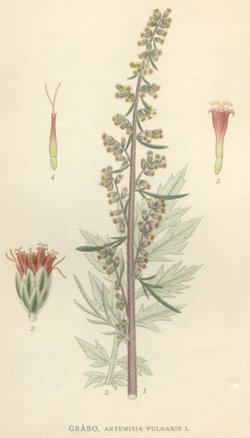Mugwort
|
|
| Mugwort | ||||||||||||||
|---|---|---|---|---|---|---|---|---|---|---|---|---|---|---|
 Mugwort (Artemisia vulgaris) | ||||||||||||||
| Scientific classification | ||||||||||||||
| ||||||||||||||
| Binomial name | ||||||||||||||
| Artemisa vulgaris |
Mugwort or Common Wormwood (Artemisia vulgaris L.), is a species from the daisy family Asteraceae. It is also known as Felon Herb, St. John's Plant, and Wild Wormwood.
It is native to temperate Europe and Asia. It is a very common plant growing on nitrogenous soils, like weedy and uncultivated areas, such as waste places and roadsides, and in wooded areas and wetlands.
It is a tall herb growing up to 1.5 meters. The deep green leaves are pinnate, with white tomentose hairs on their underside. The erect stem has often a red-purplish tinge.
The rather small flowers (5 mm long) are radially symmetrical with many petals. The narrow and numerous capitula (flower heads) spread out in racemose panicles. Mugwort flowers from July to September. The plant is used by Lepidoptera: The flowers are eaten by the larva of the Wormwood Pug and The V-Pug and the foliage by that of the Bordered Pug.
Mugwort contains ethereal oils (such as cineole, or wormwood oil, and thujone), flavonoids, triterpenes, and coumarine derivatives.
| Contents |
Culinary uses
The leaves and buds, best picked shortly before the plant flowers in July to September, are used a flavoring agent. Mugwort tastes slightly bitter.
Mugwort is used to season fat meat and fish. In Germany, it is mainly used to season goose, especially the roast goose traditionally eaten for Christmas.
In bygone days it was also used to flavour beer, before the introduction of hops to beer.
Artemisia_vulgaris0.jpg
Medicinal properties
The root of the plant is used for medicinal purposes. Mugwort was used from ancient times as a remedy against fatigue and to protect travellers against evil spirits and wild animals. Roman soldiers put mugwort in their sandals to protect their feet against fatigue. Chewing some leaves will kill the fatigue and stimulate the nervous system.
Mugwort has an aromatic smell. Poor people used mugwort, sometimes mixed with other herbs, as a substitute for tobacco. It can also be smoked mixed with or as a substitute for marijuana, it evokes a dreamy state of consciousness.
It was also used as an anthelminthic, so it is sometimes confused with wormwood (Artemisia absinthium).
Mugwort is much used in the practice of traditional Chinese medicine in a pulverized, aged, and recompounded form called moxa. Since it also causes uterine contractions, it has been used to cause abortion.
Much used in witchcraft, mugwort is useful in inducing lucid dreaming and astral travel.
Warnings
Mugwort contains thujone, which is toxic. Pregnant women, in particular, should avoid consuming large amounts of mugwort.
External links
- mugwort in Culpeper's 'The complete herbal' (http://www.bootlegbooks.com/NonFiction/Culpeper/Herbal/chap209.html)
- mugwort in Mrs Grieve's 'A modern herbal' (http://botanical.com/botanical/mgmh/m/mugwor61.html)
- Mugwort at Liber Herbarum II (http://www.liberherbarum.com/Pn0078.HTM)bg:Див пелин
da:Bynke (Artemisia) de:Beifuß eo:Artemizio fr:Armoise commune ja:ヨモギ fi:Pujo sv:Gråbo (växt)
